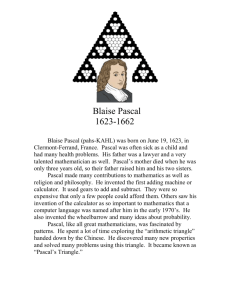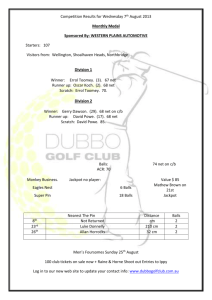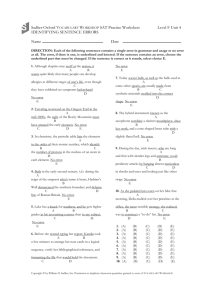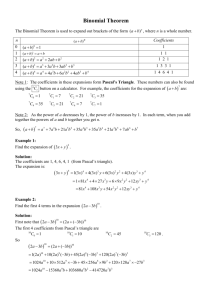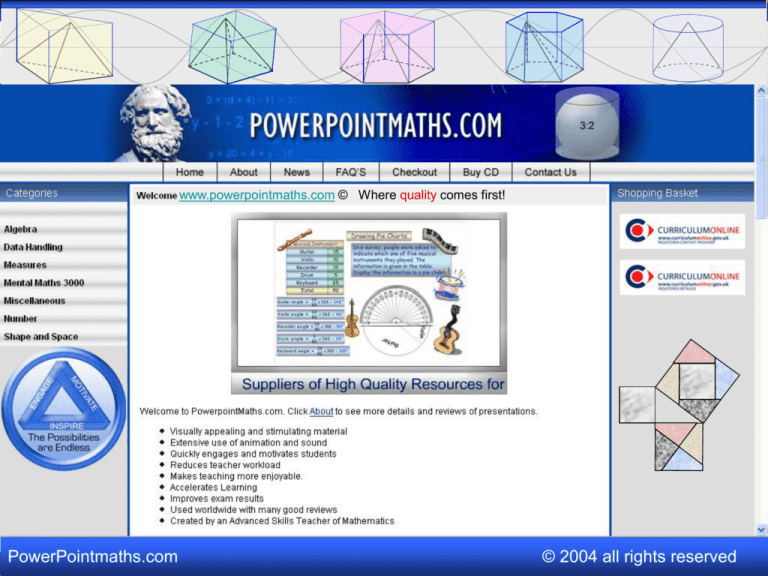
www.powerpointmaths.com © Where quality comes first!
PowerPointmaths.com
© 2004 all rights reserved
Pascal’s Triangle: The Stepping Stone Game
How many different routes
are there from the Start
stone to the Finish stone?
Stepping Stone
Game
Rules:
You can only walk
East
or
South
from any stone.
We will start by looking at 5
possible routes (be careful
how you walk)
Pascal’s Triangle: The Stepping Stone Game
1
1
1
2
1
1
1
1
1
1
How many routes are there
to:
Pascal’s Triangle: The Stepping Stone Game
1
1
1
1
2
3
1
1
1
1
1
How many routes are there
to:
Pascal’s Triangle: The Stepping Stone Game
1
1
1
1
2
3
1
3
1
1
1
1
How many routes are there
to:
Pascal’s Triangle: The Stepping Stone Game
1
1
1
1
1
1
2
3
1
3
6
1
1
How many routes are there
to:
Can you see all 6 of the
routes?
How could you have
calculated the 6 routes
without the need to draw or
visualise them?
Pascal’s Triangle: The Stepping Stone Game
1
1
1
1
1
3 routes to
this stone
1
1
1
1
2
3
3 routes to
this stone
3
6
Why must there
be 6 routes to
here?
How many routes are there
to:
Can you see all 6 of the
routes?
How could you have
calculated the 6 routes
without the need to draw or
visualise them?
What do you have to do
to get the number of
routes to any stone?
Pascal’s Triangle: The Stepping Stone Game
1
1
1
1
1
2
3
4
1
3
6
10
1
4
10
20
1
5
15
35
How many routes are there
to:
Can you see all 6 of the
routes?
How could you have
calculated the 6 routes
without the need to draw or
visualising them?
What do you have to do
to get the number of
routes to any stone?
Calculate the total
number of routes to
the finish stone.
1
5
15
35
70
Pascal’s Triangle: The Stepping Stone Game
The numbers are
Do
you noticeabout
anything
symmetrical
the
about
the
numbers
diagonal line.
produced by the routes
through
to thenumbers
finish
Counting
stone?
1
1
1
1
1
1
2
3
4
5
1
3
6
10
15
Triangular numbers
1
4
10
20
35
Tetrahedral numbers
Square
base
1
5
15
35
70
1
Pyramid
numbers
5
14
30
Pascal’s
Triangle
1
R1
1
R2
1
R3
(1623-1662)
1
R5
1
R6
1
R7
1
R8
1
R9
1
R10
1
R11
R12
R13
1
1
R4
Blaisé Pascal
1
R0
7
8
9
6
2
3
4
5
1
1
6
10 10
1
=23
8
1
5
15 20 15
3. Write the sum as a power of 2.
=22
4
4
2. Find the sum of each row.
=21
2
3
1. Complete the rest of the triangle.
=20
1
=24
16
1
6
21 35 35 21
128 =27
256 =28
1
8
9
1
10 45 120 210 252 210 120 45 10
512 =29 Tetrahedral Numbers
1
Pascal’s
1
66 220 495Triangle
792 924 792 495 220 66 12 1
11 55 165 330 462 462 330 165 55 11
12
Triangular Numbers
=26
64
1
7
36 84 126 126 84 36
=25
32
1
28 56 70 56 28
Counting/Natural Numbers
1 13 78 286 715 1287 1716 1716 1287 715 286 78 13
1024 =210
2048 =211
4096 =212
1
8192 =213
Pyramid
Numbers
(square
base)
Add the numbers shown
along each of the
shallow diagonals to find
Leonardo
of Pisa
another
well known
1180 - 1250
sequence of numbers.
The Fibonacci Sequence
1
1
1
1
1
2
3
1
1
3
1
2
3
5
1
1
1
The sequence first appears as a
recreational maths problem
about the growth in population
of rabbits in book 3 of his
famous work, Liber – abaci (the
book of the calculator).
10 45 120 210 252 210 120 45 10
1
Fibonacci
1
66 220
495 792 924 792 495 220 66 12 1
Sequence
11 55 165 330 462 462 330 165 55 11
12
13
21 34 55 89 144 233 377
Fibonacci travelled
1 4 6 4 1
extensively throughout
1 5 10 10 5 1
the Middle East and
elsewhere. He strongly
1 6 15 20 15 6 1
recommended that
Europeans adopt the
1 7 21 35 35 21 7 1
Indo-Arabic system of
numerals including the 1 8 28 56 70 56 28 8 1
use of a symbol for
1 9 36 84 126 126 84 36 9 1
zero “zephirum”
1
8
1 13 78 286 715 1287 1716 1716 1287 715 286 78 13
1
Activity: There are 5
books on a shelf.
Complete the table to
find the number of
ways that you can
choose 0, 1, 2, 3, 4
and 5 books.
Choose
Possibilities
No of Ways
0 books
-
1
1 book
2 books
A,B,C,D,E
AB, AC,AD, AE
BC, BD, BE
CD, CE
3 books
ABC, ABD, ABE
ACD, ACE
ADE
BCD, BCE
BDE,
CDE
4 books
ABCD, ABCE
ABDE
ACDE
BCDE
5 books
ABCDE
A B C D E
You will need to think
systematically!
Books 5
5
Activity: There are 5
books on a shelf.
Complete the table to
find the number of
ways that you can
choose 0, 1, 2, 3, 4
and 5 books.
Choose
Possibilities
No of Ways
0 books
-
1
1 book
A,B,C,D,E
5
2 books
AB, AC,AD, AE
BC, BD, BE
CD, CE
DE
10
3 books
ABC, ABD, ABE
ACD, ACE
ADE
BCD, BCE
BDE,
CDE
10
4 books
ABCD, ABCE
ABDE
ACDE
BCDE
5
5 books
ABCDE
1
A B C D E
You will need to think
systematically!
Relate these numbers to
entries in Pascal’s triangle.
1
R0
1
R1
A B C D E
R2
5 Books
1
1
2
1
0
1
2
3
4
5
1
5
10
10
5
1
1 3 3 1
Choose 1
Choose 2 The entries in row 5 give the
number of combinations of
1 4 6 4 1
choosing 0,1,2,3,4 and 5
1 5 10 10 5 1
books respectively.
R3
Choose 0
R4
R5
1 6 15 20 15 6 1
Choose 5
1 Choose
7 21 335 Choose
35 21 47 1
R6
R7
1
R8
R9
R10
R11
R12
R13
1
8
9
28 56 70 56 28
36 84 126 126 84 36
1
8
9
1
1 10 45 120 210 252 210 120 45 10 1
So if you wanted to know the probability of
1 11 one
330 462
55 165
462 330 165
11 1
choosing
particular
combination
of 255
books
at random, then the probability is 1/10
1 12 66 220 495 792 924 792 495 220 66 12 1
1 13 78 286 715 1287 1716 1716 1287 715 286 78 13
1
Activity: There are 6 balls
in a box as shown below.
Complete the table to find
the number of ways that
you can choose 0,1,2,
3,4,5 and 6 balls from the
box.
You will need to think even
more systematically!
Choose
Possibilities
-
0 balls
1 ball
1, 2, 3, 4, 5, 6
2 balls
12, 13, 14, 15, 16,
23, 24, 25, 26,
34, 35, 36,
45, 46,
56
3 balls
123, 124, 125, 126 134, 135, 136,
145, 146, 156,
234, 235, 236, 245, 246, 256, 345, 346,
356, 456
4 balls
1234, 1235, 1236, 1245, 1246, 1256,
1345, 1346, 1356, 1456,
2345, 2346, 2356, 2456, 3456,
5 balls
12345, 12346, 12356, 12456, 13456,
23456
6 balls
123456
No of
Ways
1
6
Activity: There are 6 balls
in a box as shown below.
Complete the table to find
the number of ways that
you can choose 0,1,2,
3,4,5 and 6 balls from the
box.
You will need to think even
more systematically!
Relate these numbers to
entries in Pascal’s triangle.
Choose
Possibilities
-
0 balls
No of
Ways
1
1 ball
1, 2, 3, 4, 5, 6
6
2 balls
12, 13, 14, 15, 16,
23, 24, 25, 26,
34, 35, 36,
45, 46,
56
15
3 balls
123, 124, 125, 126, 134, 135, 136,
145, 146, 156,
234, 235, 236, 245, 246, 256, 345,
346, 356, 456
20
4 balls
1234, 1235, 1236, 1245, 1246, 1256,
1345, 1346, 1356, 1456,
2345, 2346, 2356, 2456, 3456
15
5 balls
12345, 12346, 12356, 12456, 13456,
23456
6
6 balls
123456
1
1
R0
1
R1
1
R2
1
R3
1
R7
R9
R10
R11
R12
R13
1
2
3
1
3
0
1
2
3
4
5
6
1
6
15
20
15
6
1
1
5
6
7
10 10
5
9
The entries in row 6 give the
number of combinations of
choosing 0,1,2,3,4,5 and 6
balls respectively.
15 20 15
1
6
21 35 35 21
1
7
Choose
4
3 70
8Choose
28 56
56 28
1
R8
1
1
R6
1
1 4 16 Choose
4 1 2
Choose
ChooseR04
R5
6 Balls
36 84 126 126 84 36
Choose 6
1
5
1
8Choose
9
1
1
1 if 10
120 45 10
210probability
120 210
252 the
So
you 45
wanted
to know
of
combination
1choosing
330 462 462
330 165 of
553 11 1
165particular
11 55 one
balls at random, then the probability is 1/20
1 12 66 220 495 792 924 792 495 220 66 12 1
1 13 78 286 715 1287 1716 1716 1287 715 286 78 13
1
Use Pascal’s triangle
to determine how
many ways there are
of choosing:
(a) 2 balls
66
(b) 5 balls
792
(c) 9 balls
220
1
R0
1
R1
1
R2
1
R3
1
R4
R5
1
R6
5
6
2
3
4
1
1
1
10 10
nC
r
1
2
3
4
n choose r
5
6
7
8
9
10 11 12
1
3
6
12 Balls
4
1
5
15 20 15
Find the combination key
on a scientific calculator
and evaluate.
1
6
1
12C
2
1 7 21 35 35 21 7 1
R
The
7 probability of choosing one particular
combination
of 556
balls70is 1/792
1 8 28
56 28 8 1
R8
R9
R10
R11
R12
R13
1
9
36 84 126 126 84 36
9
12 choose 2
12C
5
1
Balls 12
1 10 45 120 210 252 210 120 45 10 1
Choose 0
1 11 55 165 330 462 462 330 165 55 11 1
1
12 66 220 495 792 924 792 495 220 66 12
1 13 78 286 715 1287 1716 1716 1287 715 286 78 13
12 choose 5
1
1
12C
9
12 choose 9
Use Pascal’s triangle
to determine how
many ways there are
of choosing:
(a) 3 books
56
(b) 4 books
70
(c) 6 books
28
1
1
R4
1
R5
R7
1
2
3
4
5
1
1
1
3
6
10 10
4
1
5
1
Now do it on a calculator.
1 6 15 20 15 6 1
Choose 0
1 7 21 35 35 21 7 1
1
R8
R9
1
R2
R3
R6
1
R1
8 Books
nC
r
1
R0
8
9
28 56 70 56 28
Books
36 84 126 1268
84
36
8C
3
1
8
9
1
8C
4
1 10 45 120 210 252 210 120 45 10 1
R10
The probability of choosing one particular
1 11 55 165 330 462 462 330 165 55 11 1
R11
combination of 4 books is 1/70
1 12 66 220 495 792 924 792 495 220 66 12 1
R12
R13
1 13 78 286 715 1287 1716 1716 1287 715 286 78 13
1
8C
6
1
R0
nC
r
1
R1
1
R2
1
R3
1
2
3
1
1
3
In how many ways can
a 5-a-side team be
chosen from a squad
R5 1 5 10 10 5 1
of 10 players?
1
6
15
20
15
6
1
TheR6probability of choosing one particular
252
combination
is 1/252
1 7of 521players
35 35
21 7 1
R
R4
1
4
6
4
1
7
1 8 28 56 70 56 28 8 1
R8 Choose
0
1 9 36 84 126 126 84 36 9 1
R9
1
R10
1
R11
R12
R13
1
10 45 120 210 252 210 120 45 10
10C
5
1
11 55 165 330 462 462 330 165 55 11
1
5-a-side
12 66 220 495 792 924 792 495 220 66 12
1 13 78 286 715 1287 1716 1716 1287 715 286 78 13
1
1
Remember: The top row is Row 0
1
Use Pascal’s triangle to
determine the number of
combinations for each of
the following selections.
1
1
1
1
1
1
1
1
1
1
1
1
7
8
9
6
2
3
4
5
1
1
1
3
6
10 10
4
1
5
15 20 15
1
6
21 35 35 21
1
1
7
28 56 70 56 28
36 84 126 126 84 36
1
8
9
1
10 45 120 210 252 210 120 45 10
1
11 55 165 330 462 462 330 165 55 11
1
12 66 220 495 792 924 792 495 220 66 12
1 13 78 286 715 1287 1716 1716 1287 715 286 78 13
1
1
A
C
1
1
1
1
1
Choose 3 books
1
1
B
1
1
1
1
Choose 5
players
1
1
7
8
9
6
2
3
4
5
1
1
1
3
6
10 10
4
Choose 7 cards
1
5
15 20 15
1
6
21 35 35 21
1
1
7
28 56 70 56 28
36 84 126 126 84 36
D
1
8
9
1
10 45 120 210 252 210 120 45 10
Mix
1
11 55 165 330 462 462 330 165 55 11
1
2
3
4
5
6
7
8
9
Choose 4 balls
1
12 66 220 495 792 924 792 495 220 66 12
1 13 78 286 715 1287 1716 1716 1287 715 286 78 13
1
1
49 balls choose 6
National Lottery Jackpot?
1
12
7
49
21
31
1
30
17
1
1
20
3
45
1
13
1
43
39
16
4
9
1
46
1
5
42
1
1
10
28
1
2
1
34
29
1
9
6
7
8
5
2
36
1
6
10 10
4
25
24
1
3
15
33
38
1
3
4
11
1
1
5
15 20 15
14
37
1
6
21 35 35 21
?
35
22
1
28 56 70 56 28
36 84 126 126 84 36
44
40
1
7
19
1
8
9
32
47
1
10 45 120 210 252 210 120 45 10
8
26
23
6
1
11 55 165 330 462 462 330 165 55 11
1
Lottery
12 66 220 495 792 924 792 495 220 66 12
1 13 78 286 715 1287 1716 1716 1287 715 286 78 13
41
18
1
27
1
48
National Lottery Jackpot? Row 0
12
7
31
49C
6
39
16
4
9
46
34
2
29
42
5
There are 13 983 816 ways of
choosing 6 balls from a set of
49. So buying a single ticket
means that the probability of a
win is 1/13 983 816
10
28
25
1
13
43
36
24
3
45
15
33
38
30
17
20
11
49
21
49 balls choose 6
Choose 6
35
14
37
19
22
44
40
32
47
8
26
23
6
41
18
27
Row 49
13 983 816
48
Pascal’s Triangle on a Spreadsheet
A B C D E
F G …
1. Enter 1’s along rows and
down columns. Go down to
row 50 for jackpot odds.
1
2
3
4
5
6
7
8
Spreadsheet
Pascal’s Triangle on a Spreadsheet
1
2
3
4
5
A B C D E
1 1 1 1 1
1
1
1
1
6
7
8
1
1
1
F G …
1 1
1. Enter 1’s along rows and
down columns. Go down to
row 50 for jackpot odds.
2. In cell B2 enter the
formula =B1+A2 then fill
right.
Pascal’s Triangle on a Spreadsheet
1
2
3
4
5
A B C D E
1 1 1 1 1
1 2 3 4 5
1
1
1
6
7
8
1
1
1
F G …
1 1
6
7
1. Enter 1’s along rows and
down columns. Go down to
row 50 for jackpot odds.
2. In cell B2 enter the
formula =B1+A2 then fill
right.
3. Fill down as far as row
50. Remember that row 1
on the spreadsheet
corresponds to row 0 in
Pascal’s triangle.
Pascal’s Triangle on a Spreadsheet
1
2
3
4
5
A B C D E F G …
1 1 1 1 1 1 1
1 2 3 4 5 6 7
1 3 6 10 15 21 28
1 4 10 20 35 56 84
1 5 15 35 70 126 210
6
7
8
1
1
1
6
21
56
1. Enter 1’s along rows and
down columns. Go down to
row 50 for jackpot odds
2. In cell B2 enter the
formula =B1+A2 then fill
right.
3. Fill down as far as row
50. Remember that row 1
on the spreadsheet
corresponds to row 0 in
Pascal’s triangle.
126 252 462
7
28
84
210 462 924
8
36
120 330 792
1716
4. Use a step-up
procedure to see each row
more clearly.
Row 3
Row 6
Pascal’s Triangle on a Spreadsheet
42
43
44
45
46
47
1
1
1
1
1
1
48 1
49 1
50 1
42
43
44
13 983 816
45
46
Row 49
47
6th entry
48
49
50
Historical Note
Blaisé Pascal
(1623-1662)
Pascal was a French mathematician whose contemporaries
and fellow countrymen included Fermat, Descartes and
Mersenne. Among his many achievements was the
construction of a mechanical calculating machine to help his
father with his business. It was able to add and subtract only,
but it was a milestone on the road to the age of computers.
He corresponded with Fermat on problems that led to the new
branch of mathematics called Probability Theory. The two
problems that they examined concerned outcomes when
throwing dice and how to divide the stake fairly amongst a
group of players if a game was interrupted.
Historical Note
These investigations led Pascal to construct tables of
probabilities that eventually led to the triangle of probabilities
that bears his name.
Pierre de Fermat
(1601 – 1675)
The Binomial Expansion
Pascal used his triangle to find the coefficients in the expansion of (a + b)n
The coefficients of each term correspond to the entries in the nth row.
1
Binomial Expansion
1
(a + b)2 = a2 +2ab +b2
1
1
(a + b)3 = a3 +3a2b +3ab2 + b3
(a + b)4 = a4 + 4a3b +6a2b2 + 4ab3 + b4 1
(a + b)5 = a5 + 5a4b +10a3b2 + 10a2b3 + 5ab4 +b5 1
1
1
(a + b)8 = a8 + a7b +
a6b2 +
a5b3 +
a4b4 +
6
7
8
2
3
4
5
1
1
1
1
3
6
10 10
4
1
5
15 20 15
1
6
21 35 35 21
28 56 70 56 28
a3b5 +
1
1
7
8
a2b6 + ab7 + b8
(a + b)8 = a8 + 8a7b + 28a6b2 + 56a5b3 + 70a4b4 + 56a3b5 + 28a2b6 + 8ab7 + b8
1
Pascal’s Triangle: The Stepping Stone Game
Worksheet 1
Worksheet 2
1
1
1
1
1
1
1
1
1
1
1
1
1
7
8
9
6
2
3
4
5
1
1
1
3
6
10 10
4
1
5
15 20 15
1
6
21 35 35 21
1
1
7
28 56 70 56 28
1
8
36 84 126 126 84 36
9
1
10 45 120 210 252 210 120 45 10
Worksheet 3
1
11 55 165 330 462 462 330 165 55 11
1
12 66 220 495 792 924 792 495 220 66 12
1 13 78 286 715 1287 1716 1716 1287 715 286 78 13
1
1
Choose
Possibilities
No of Ways
0 books
-
1
1 book
2 books
A,B,C,D,E
5
AB, AC,AD, AE
BC, BD, BE
CD, CE
3 books
ABC, ABD, ABE
ACD, ACE
ADE
BCD, BCE
BDE,
CDE
4 books
ABCD, ABCE
ABDE
ACDE
BCDE
5 books
ABCDE
Worksheet 4
Choose
Possibilities
-
0 balls
No of
Ways
1
1 ball
1, 2, 3, 4, 5, 6
2 balls
12, 13, 14, 15, 16,
23, 24, 25, 26,
34, 35, 36,
45, 46,
56
3 balls
123, 124, 125, 126 134, 135, 136,
145, 146, 156,
234, 235, 236, 245, 246, 256, 345, 346,
356, 456
4 balls
1234, 1235, 1236, 1245, 1246, 1256,
1345, 1346, 1356, 1456,
2345, 2346, 2356, 2456, 3456,
5 balls
12345, 12346, 12356, 12456, 13456,
23456
6 balls
123456
6
Worksheet 5


